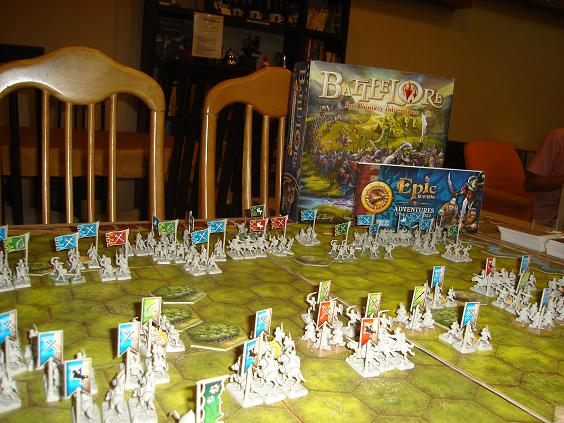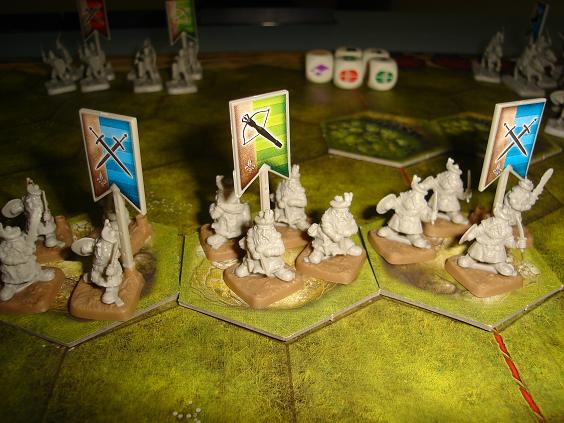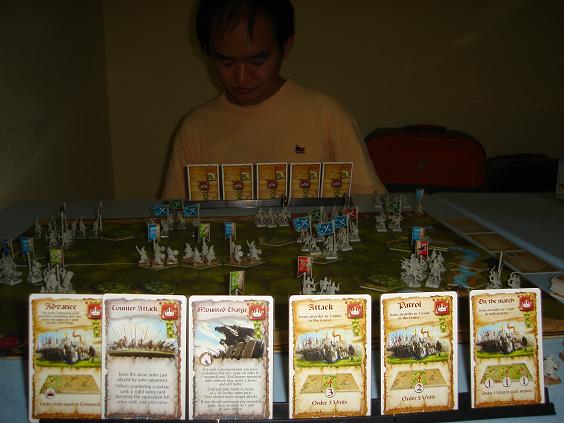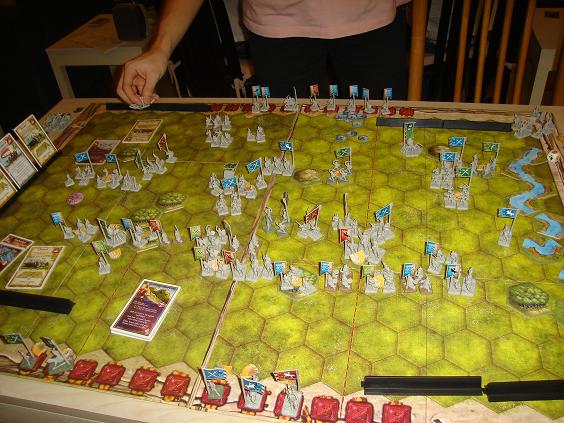Battlelore was one of the first games we bought when we started the hobby. There’s just something so attractive and wonderful about two armies of plastic miniatures facing down each other on a brightly colored battlefield. You can practically hear the clashing of swords as the opposing walls of infantry meet each other, the thundering hooves of cavalry charging down broken and demoralized troops, the zipping of arrows streaking across the sky etc. With so much stuff in the box plus the fact that it’s strictly a two-player game, we just had to have it.
Months later, I still enjoy the game very much but I have to sheepishly admit that we haven’t played it as much as we should and have only made it through just about half of the included scenarios. The main problem is that setting it up takes quite a bit of time. Counting out all of the correct terrain tiles and unit banners, placing them all on the board and then filling out all of the units to full strength with the proper miniatures takes me nearly half an hour. After that the actual game only takes about an hour to finish. Most of the time, we play the same map twice in a row alternating which side we control but the initial setting up time is still discouraging.
This apart, the game is excellent. One of the perennial problems faced in designing miniatures-based wargames is how to allow players to move their units. The easiest solution, allowing each player to take turns to move all of his units, is unsatisfying. One reason is that it gives the starting player a huge advantage in improving upon his units’ starting position but possibly also in decimating part of the opponent’s forces before he has even played a turn! Another reason is that it turns the game into a mechanistic, predictable affair, like an elaborate game of chess with dice determining the results of battles.
Richard Borg’s Command and Colors system neatly solves this by forcing players to play the appropriate card in order to command his units. These cards are divided into two types. Section cards allow the player to command a specified number of units in the appropriate section of the battlefield, right flank, center or left flank, while the tactics cards apply to either a specific type of unit or units of a certain color, which denotes its quality level. Every turn, each player gets to play a card from his hand and draw a new one. Only units that are affected by the played card get to move and attack.
This adds not only dynamism but also an additional layer of strategy into the game. In addition to the tactical considerations on the battlefield, players need to have hand management skills as well. If you have a hand full of cards for the left flank, for example, it makes sense to use your other cards to move as many of your units as you can into that section. Since each card can command a variable number of units, it’s obvious that some cards are more powerful than others. Do you use a card that can move five units now to quickly rearrange your army into a solid formation or hold it until the enemy is close enough that you can attack with all five units at once?
The rest of the mechanics are fairly conventional. When attacking, each unit gets to roll a number of dice determined by how well trained and equipped it is. Green units denoting raw recruits roll two dice. Blue units, which are regular troops, roll four dice, while the elite red units roll four dice. The results are then interpreted according to what weapon the attacking unit is equipped with and what types of unit the target is. Other rules like morale and extra attacks by cavalry who decimate their first targets add more tactical options to consider.
The main thing that sets Battlelore apart from the other games that use this system are the Lore cards, which are basically magical spells that can be used for a variety of effects. I can’t say that I really like this much and judging by the posters on BGG who prefer more medieval adventure scenarios to ones that use Lore, I guess I’m not the only one. Between the command cards and the dice, I’m inclined to believe that there’s already enough variety and randomness in the game. I’d prefer to see more special units, terrain types and scenario specific rules than Lore cards.
Overall I think it’s a great game and fantastic value for money for all the stuff you get in the box and how much replay potential the game has. I keep thinking about buying expansions for it, especially Call to Arms which adds a unit drafting system instead of using preset armies according to each scenario, but feel guilty when I think about all the scenarios in the base game I still have yet to play through.
Some of the photos here are from an Epic Battlelore session with my wife and I on one team and Sean and his wife, Sara, on the opposing team. This involves joining two normal boards together to form a large battlefield. Needless to say we were badly trounced especially since Sean played an evil, evil Lore card that severely depleted our forces. We played the Reluctant Allies variant which has each player holding a hand of cards commanding half of the overall battlefield and it was quite fun, though trying to work out how to properly coordinate strategy with your partner can be quite a headache. Apparently the normal version of the rules involves only one hand of cards for each side and with one player distributing the cards to the appropriate section general. We had a chance to play this way with a big game of Memoir ’44 recently but that’s going to have to be a post for another day.




3 Responses to “Battlelore”
Trackbacks
Leave a Reply